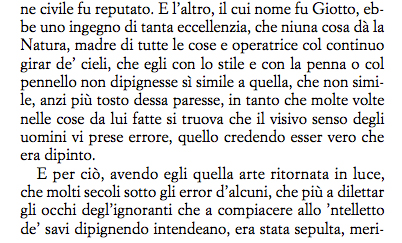
|
Current art history news, comments, updates, pictures, videos, reviews, & information posted on FACEBOOK by Dr. Christopher L.C.E. Witcombe
|
Links to art history resources

|
|
— ART HISTORY & IMAGE STUDIES —
Art & Theory in Baroque Europe
 ARTH 344 ARTH 344  FALL 2016 FALL 2016  SCHEDULE SCHEDULE  REQUIREMENTS REQUIREMENTS 
Christopher L.C.E. Witcombe
|
|
High Art vs. Low Art
Giovanni Boccaccio
excerpt from The Decameron, c. 1349-1351
(6th Day, 5th Tale)

"The other was Giotto, whose genius was of such excellence that with his art and brush or crayon he painted anything in Nature, the mother and mover of all things under the perpetual turning of the heavens, and painted them so like that they seemed not so much likenesses as the things in themselves; whereby it often happened that men's visual sense was deceived, and they thought that to be real which was only painted.
Now he who brought back to light that art which for many centuries had lain buried under errors (and thus was more fitted to please the eyes of the ignorant than the minds of the wise), may rightly be called one of the shining lights of Florentine glory."
Giovanni Boccaccio / The Decameron / Giotto
Giovanni Pietro Bellori
excerpt from an essay that was later included in Bellori's Le vite de' Pittori, Scultori et Architetti moderni (Rome, 1672), 1: 11. The translation is taken from the English edition of Erwin Panofsky, Idea, A Concept in Art Theory. Translated by Joseph J. S. Peake (Columbia, S.C.: University of South Carolina Press, 1968), 155-75.

"The common people refer everything they see to the visual sense. They praise things painted naturally, being used to such things; appreciate beautiful colors, not beautiful forms, which they do not understand; tire of elegance and approve of novelty; disdain reason, follow opinion, and walk away from the truth in art, on which, as on its own base, the most noble monument of the Idea is built."
Giovanni Pietro Bellori / Idea
Michelangelo
on Flemish and Italian painting. In a translation from the Portuguese of a passage in Diálogos de Roma in Francisco de Holanda's Da pintura antiga (Lisbon, 1548).
"Flemish painting will, generally speaking, please the devout better than any painting in Italy, which will never cause him to shed a tear, whereas that of Flanders will cause him to shed many; and that not through the vigor and goodness of the painting but owing to the goodness of the devout person. It will appeal to women, especially to the very old and the very young, and also to monks and nuns and to certain noblemen who have no sense of true harmony. In Flanders they paint with a view to external exactness or such things as may cheer you and of which you cannot speak ill, as for example saints and prophets. They paint stuffs and masonry, the green grass of the fields, the shadows of trees, and rivers and bridges, which they call landscapes, with many figures on this side and many figures on that. And all this, though it pleases some persons, is done without reason or art, without symmetry or proportion, without skillful choice or boldness, and, finally, without substance or vigor. Nevertheless there are countries where they paint worse than in Flanders. And I do not speak so ill of Flemish painting because it is all bad but because it attempts to do so many things well (each one of which would suffice for greatness) that it does none well . . .
And at its best nothing is more noble or devout [than true Italian painting], since with discreet persons nothing so calls forth and fosters devotion as the difficulty of a perfection which is bound up in union with God. For good painting is nothing but a copy of the perfections of God and a recollection of His painting; it is a music and a melody which only intellect can understand, and that with great difficulty. And that is why painting of this kind is so rare that no man may attain it.
And further I say (and he who notes this will appreciate it): There is no clime or country lit by sun or moon outside the kingdom of Italy where one can paint well . . .
Therefore I declare that no nation or people (I except one or two Spaniards) can perfectly attain or imitate the Italian manner of painting (which is that of ancient Greece) in such a way that it will not immediately be seen to be foreign, however much they may strive and toil. And if by some great miracle one of them attains excellence in painting, then, even though his aim were not to imitate Italy, we say merely that he has painted as an Italian. Thus we give the name of Italian painting not necessarily to painting done in Italy but to all good and right painting; and because Italy produces more masterly and more noble works of splendid painting than any other region, we call good painting Italian, and if good painting be produced in Flanders or in Spain (which has most affinity with us) it will still be Italian painting. For this most noble science belongs to no country; it came down from heaven; yet from of old it has always remained in our Italy more than in any other kingdom on earth, and so I think it will be to the end.
In Italy great princes as such are not held in honor or renown; it is a painter that they call divine."
Francisco de Holanda / Michelangelo / Flemish Painting / Italian Renaissance Painting
|
|
|
© Christopher L. C.E. Witcombe
|

